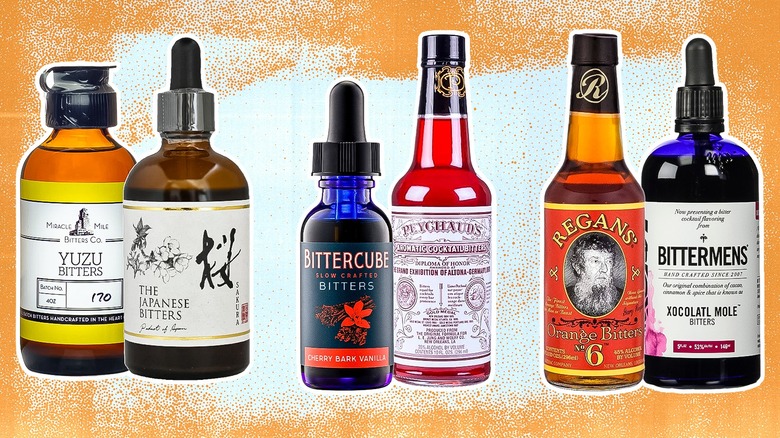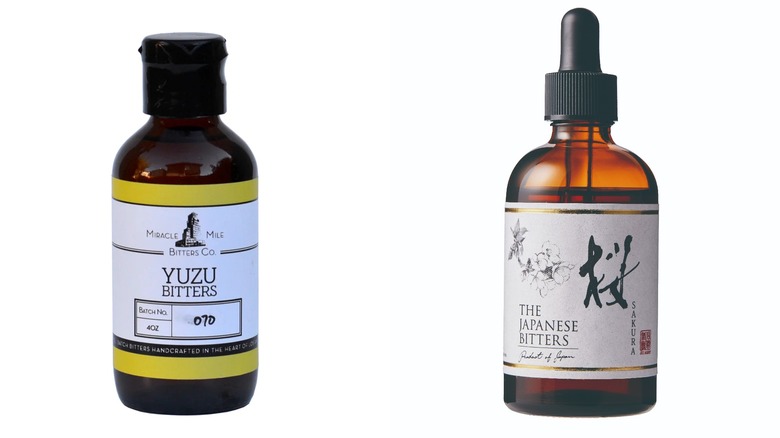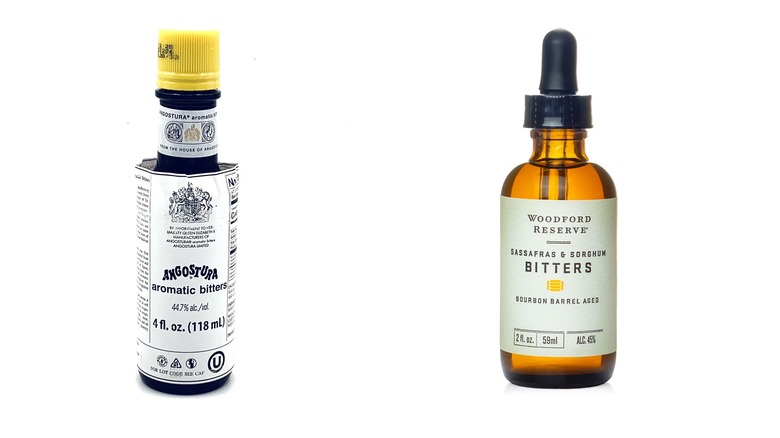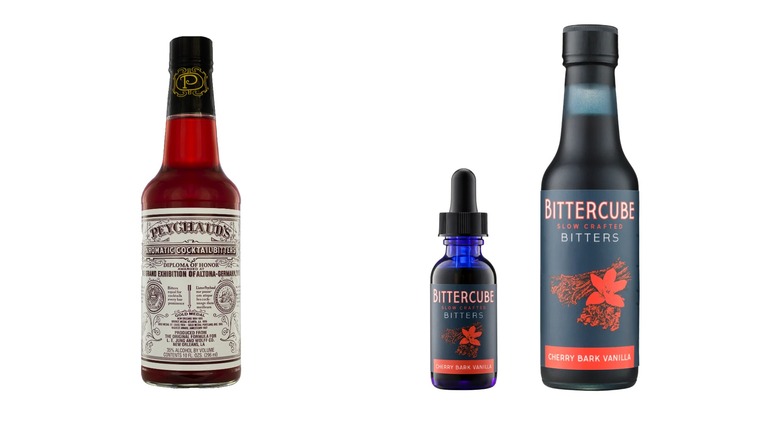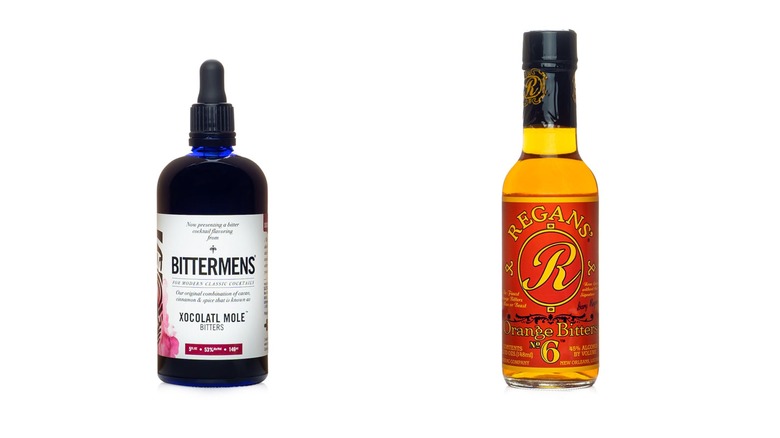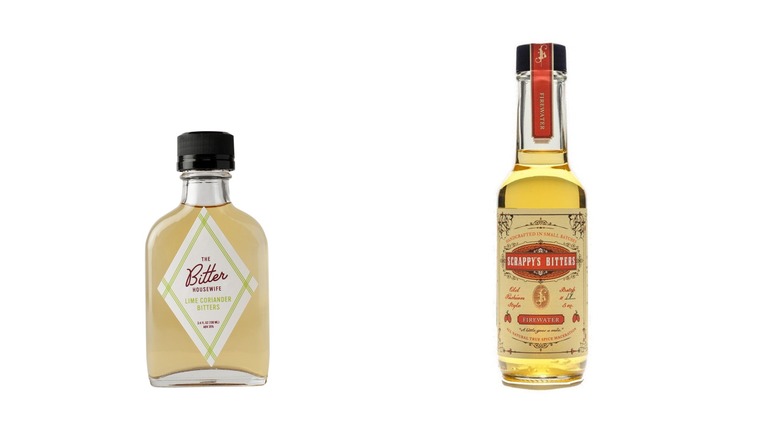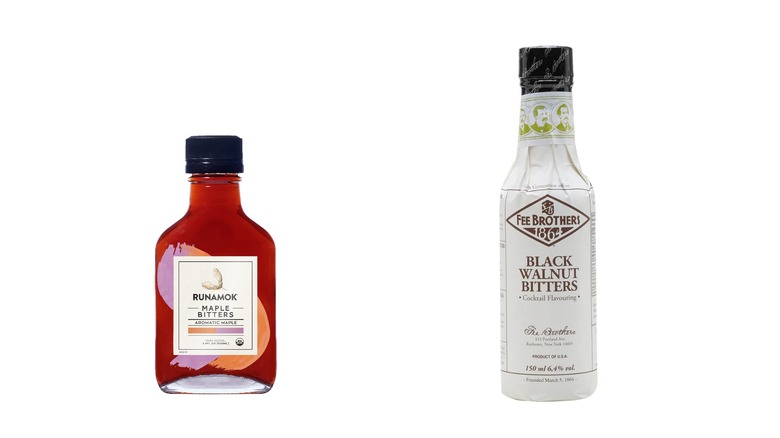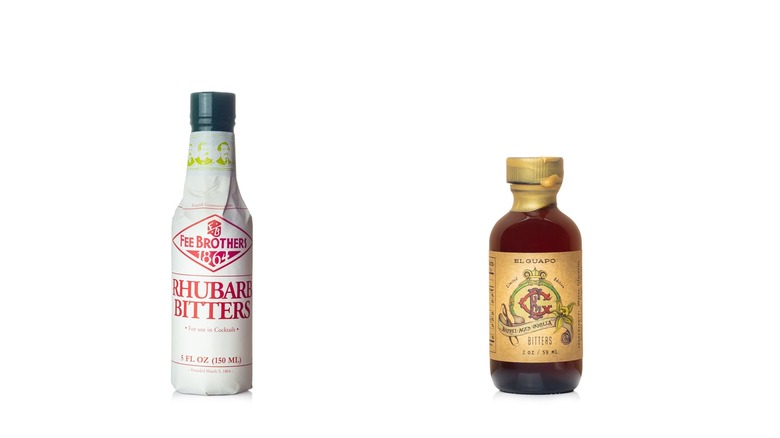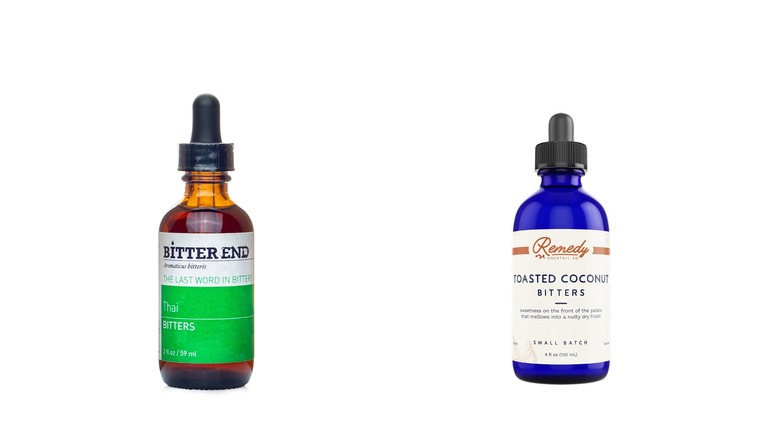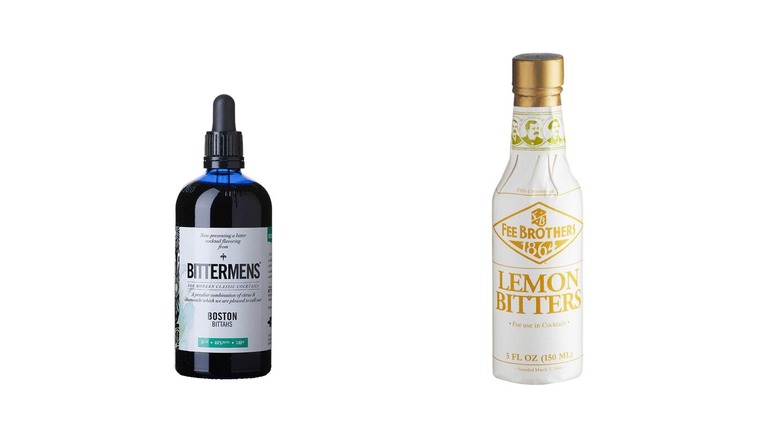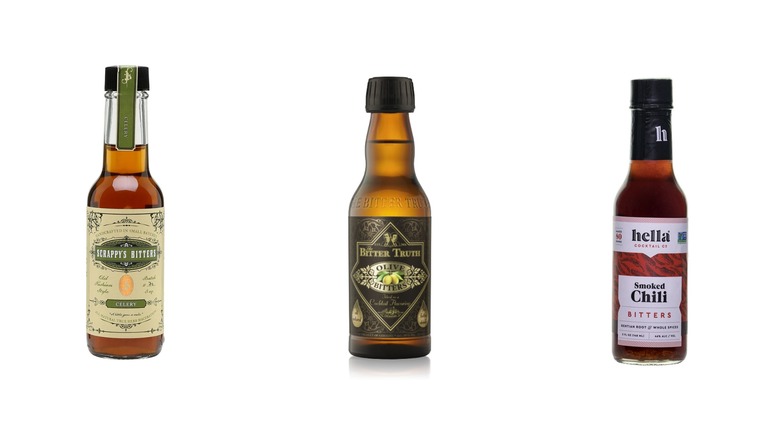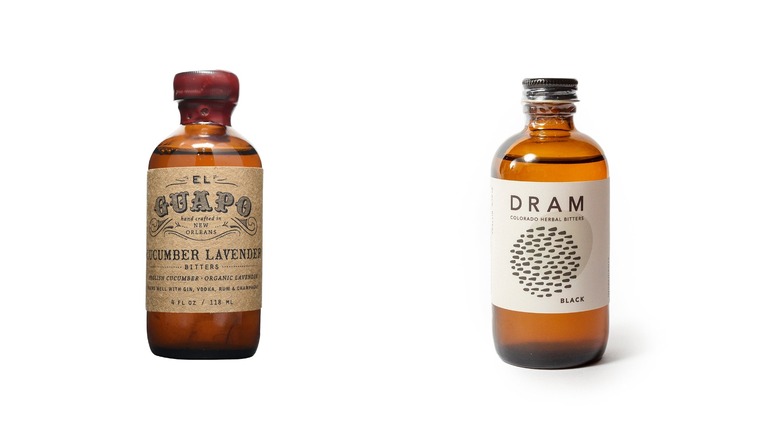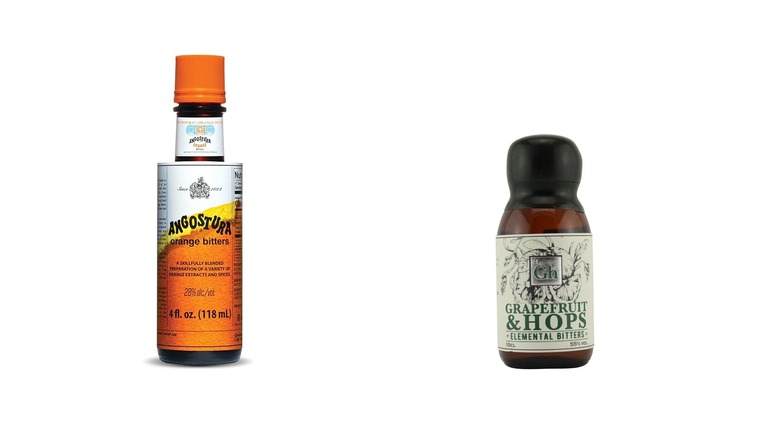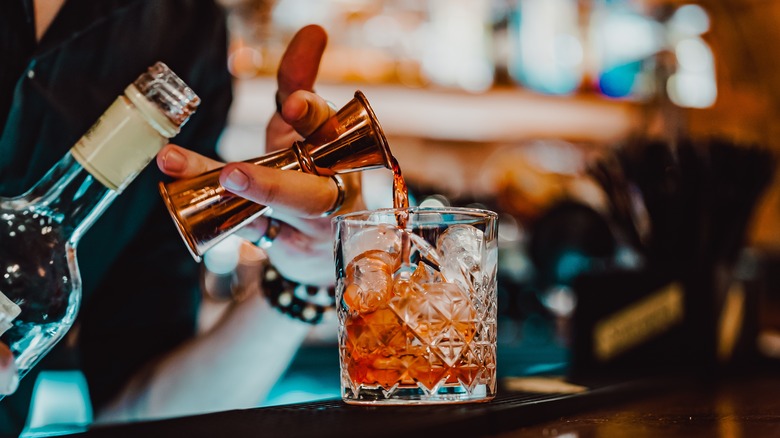13 Combinations Of Bitters You Should Try For An Unforgettable Cocktail, According To A Bartender
If you're a fan of cocktails, then you'll have likely tasted the difference between a great drink and an unforgettable one. Sometimes, the difference is the ingredients' quality or the bartender's talent. But more often than not, it's about finding the missing element that ties all of the components together and transforms the cocktail into something more than the sum of its parts.
While that missing element could be any number of things, it's frequently a few dashes of cocktail bitters. Bitters are simply a neutral spirit infused with various ingredients — like roots and herbs — and nowadays, there's a huge range of different flavors to pick from. I previously ranked some of my favorite bitters brands, but there are times when a single style isn't enough. I've spent over 16 years in the hospitality industry, traveling the world and creating cocktails as a bartender in a variety of award-winning venues, ranging from dive bars to fine-dining restaurants. Below, I share the most impactful combinations of bitters I've discovered in this time, including my own inventions and some from my contemporaries in the bar world — as they were used in drinks I can only describe as unforgettable.
Miracle Mile Yuzu and The Japanese Bitters Sakura
Although I'd had a vague understanding of what bitters were, it wasn't until I moved to Melbourne, Australia, that I began truly learning about the world of cocktails. While staying with my cousin who'd spent 20 years making his name in the Melbourne bar scene, I visited him at the Asian fusion bar he was managing.
I had no idea what to order but knew I liked gin, and within a few moments, I was presented with a martini glass adorned with a sprig of cherry blossom. I was intrigued the moment I set eyes on it. The name of the drink escapes me, but this was a martini made with Japanese gin that had an extraordinarily unique floral profile. The secret, he told me, was bitters. Specifically, a combination of Miracle Mile's yuzu bitters — made with the unique citrus fruit used liberally in Japanese cuisine – and The Japanese Bitters' sakura bitters, crafted with cherry blossom petals and leaves. The tart, aromatic yuzu cut through the delicate cherry blossom flavors and found perfect harmony with the herbaceous gin. It's a combination I've since found is ideal in a whisky highball, an extremely popular Japanese cocktail.
Angostura and Woodford Reserve Sassafras and Sorghum
Once my interest in cocktails was well and truly piqued, I began working my way through the classics and immediately fell in love with old fashioneds. Although I hadn't started working with cocktails yet, I bought a bottle of Woodford Reserve on my cousin's recommendation and began experimenting with variations of the cocktail at home.
I quickly understood why Angostura bitters, with its curiously oversized label, was so ubiquitous and such a popular choice for cocktails. But I felt I could do more to elevate my old fashioneds. When I realized Woodford Reserve had its own range of bitters, I ordered a handful of bottles and got to work. Although there's something to be said for the entire range, it was the sassafras and sorghum tincture that offered the rich, earthy sweetness I was looking for. On its own, the Woodford bitters were still overpowered by the whiskey, so I added a dash of the spicy cinnamon and clove-forward Angostura as well. It's a combination I've always gone back to and found it works well in dozens of whiskey-based cocktails, especially Manhattans, Rob Roys, and Sazeracs.
Peychaud's and Bittercube Cherry Bark Vanilla
Another of the first bitters I encountered was the iconic Peychaud's, famously used in classics like the Sazerac and Vieux Carré. I was intrigued by how Peychaud's was similar to Angostura but more fruit-forward, with notes of candied cherry, herbal anise, and spicy citrus.
When I joined Wellington's Laundry Bar, something of a local institution that has since sadly closed its doors, it was a couple of weeks before the city's famous food festival, Welly on a Plate. Known for slinging exceptional burgers from their caravan kitchen, Laundry's entry was the Bali-inspired Sumatran steak burger, but it needed a bespoke cocktail to go with it. I sat down with the bar manager — my first mentor in mixology — and we sought to create something boozy with a sweet edge to cut through the rich, slow-cooked beef and spicy slaw. He spun up an Indonesian-inspired twist on a daiquiri with Batavia Arrack and Maraschino liqueur, but he was stuck on the bitters. Peychaud's instantly sprung to mind, but Bittercube's cherry bark vanilla took the Sumatran Daiquiri to the next level. The two are similar in profile, but the sweet vanilla, bitter almonds, and earthy cocoa elements of the latter amplified the former, and it's now a combo I use to boost recipes that usually call for Peychaud's.
Bittermens Xocolatl Mole and Regan's Orange No. 6
The first cocktail book I bought was by Death & Co., one of the world's most highly acclaimed cocktail bars. The bar's manager and cocktail legend, Phil Ward, is a huge proponent of tequila, and his world-famous Oaxaca Old Fashioned made me realize tequila's potential as a base spirit in cocktails.
Wanting to create something similar for the Laundry menu, I started to play around with añejo tequila-based old fashioneds and agave syrup. Regan's orange bitters, with savory notes of coriander, cardamom, and caraway was an immediate winner, but the cocktail was lacking depth. I'd been reading about cocoa bitters and how to use them and decided to give Bittermens' Xocolatl mole bitters a try. With ingredients inspired by Mexican cuisine, these bitters added a new level of complexity to the aged tequila while perfectly complementing the rich Regan's. The chocolate-orange combination works in plenty of dark spirit-based cocktails, effortlessly complementing aged whiskeys, rums, and tequilas alike.
The Bitter Housewife Lime Coriander And Scrappy's Fire Tincture
At this point, I was still diving deep into the world of tequila and its smoky cousin, mezcal, due to the revelation that there was more to the agave-based spirit than shots, lemon, and salt. I was still getting to grips with cocktail creation, so I decided to Mr. Potato Head existing cocktails to familiarize myself with the principles of flavor balancing.
The result was the Smoke & Spice margarita — my second sole creation to make it onto a cocktail menu — which combined mezcal with rosemary-infused tequila for the base with a Cajun-rub rim. However, I was struggling to get a balanced level of spice — infusing the tequila with chili was a time-sensitive affair that resulted in too much heat. The answer was Scrappy's habanero-infused fire tincture, which allowed me a lot more control over the piquancy of the drink. However, its delicate sweetness was still being overpowered by the base spirits, which is where The Bitter Housewife's lime coriander bitters came in. Together, these two offer a spicy, savory complexity that can bolster bloody marias, or make a tequila slammer much more palatable.
Amargo Chuncho and Dr Adam's Spanish Bitters
While working in Wellington, I realized there was a sizable Chilean diaspora after consistently being asked whether we served pisco. This isn't the place to get into the ongoing debate of whether the distilled grape spirit is Chilean or Peruvian in origin. But needless to say, I soon added a bottle to the ordering list to familiarize myself with it.
I also ordered a bottle of Amargo Chuncho bitters, a Peruvian tincture that many claim is critical for making an authentic pisco sour cocktail. Named after an indigenous tribe who stood up to Spanish conquistadors, Chuncho bitters lent cinnamon, allspice, and nutmeg to the sour, plus a delicious element I can only describe as cherry cola.
For weeks, we'd had a bottle of Dr Adams' Spanish bitters sitting on the back bar that we'd struggled to find a use for, and I finally realized where its spicy citrus and floral berry profile would work. It's a combination that not only makes a superb pisco sour, but its fruity, baking spice characteristics mean it's incredibly versatile, tying together light and dark spirits, as well as fruity and floral components.
Runamok Aromatic Maple and Fee Brothers Black Walnut
One of the reasons I learned so much about cocktails in Wellington was the vibrant and cohesive hospitality scene that constantly challenged and inspired me. On nights off or after an early finish, bartenders would flock to The Hanging Ditch, a cocktail venue that was continuously pushing the boundaries of mixology.
A fan favorite drink was their Blackwater Bay, inspired by its creator's "Game of Thrones" addiction with a recipe that was never fully disclosed. However, we knew the base was a Speyside Scotch and Pedro Ximénez sherry, balanced with a winning pairing of Runamok's aromatic maple bitters and Fee Brothers black walnut bitters. It was a cocktail that could've fallen flat, but the tinctures added an earthy bittersweetness that deftly tied the base spirits together. This duo is also fantastic in a maple syrup old fashioned and rye-based cocktails, like Manhattans and whiskey gingers.
Fee Brothers Rhubarb and El Guapo Barrel Aged Vanilla
When I first got into cocktails, I had an aversion to sweeter, dessert-like drinks. More often than not, they were cloying and unbalanced, but my first encounter with a Brandy Alexander showed me this didn't have to be the case.
When I started to experiment with egg whites and their plant-based alternative, aquafaba, to make deliciously frothy sours, I realized they had the perfect texture and tartness to work as a base for a dessert cocktail. Inspired by classic British desserts like rhubarb crumble and raspberry ripple ice cream, I started working on what would become the Raspberry Ripple Sour. With a base of fruity raspberry-flavored Chambord and sweet bourbon, I was nearly there, but the bitters I was using were too savory. However, the sherbet-like tang of Fee Brothers' rhubarb bitters and the creamsicle qualities of El Guapo's barrel-aged vanilla bitters were everything I needed to round out the cocktail without making it too saccharine. The combo was the gift that kept on giving, and I found it was also a great addition to rum-based drinks like tiki cocktails and Cuba Libres.
The Bitter End Thai and Remedy Toasted Coconut
After Laundry Bar, I found myself in my first beverage manager role at Charley Noble, a restaurant with New Zealand's equivalent of a Michelin star. It was the first time I'd been given full responsibility for creating a cocktail menu, so I turned to the restaurant's heritage for inspiration.
Based in a building that was once home to a sizable shipping company, I decided to base my cocktails on the company's notable ships. First up was The Wanganella, which saw time as a hospital ship in Borneo, so I looked to Asian cuisines for ideas. The base consisted mainly of a peanut butter fat-washed vodka, influenced by satay, and it was layered with light kaffir lime-infused coconut cream and rimmed with chili salt. For bitters, I turned to The Bitter End — known for innovative, cuisine-inspired tinctures — and found their Thai bitters were exactly the kick the drink needed. However, they began to overpower the coconut cream until I added Remedy's toasted coconut bitters to the mix. The coconut element is everything the Thai bitters are missing, and together, they can add a Southeast Asian twist to everything from mojitos to gin and tonics.
Bittermens Boston Bittahs and Fee Brothers Lemon
My personal favorite of my ship-based cocktails was The Nelson, a cocktail in which I aimed to capture the essence of an English garden. I started with gin, infused with earthy green tea and zingy lemon peel, and balanced it with honey gomme, St Germain elderflower liqueur, and lemon juice.
Still a sucker for a sour, I used egg white to give it a delightfully frothy, creamy texture; a garnish of fresh thyme deepened its herbaceous aroma. The citrus was still slightly overpowered by the other components, and a few dashes of Fee Brothers lemon were enough to bring that element back into play. Though it was still lacking something, I didn't want to add any extra ingredients that would make the drink taste "brown" or "muddy" — terms that Death & Co's Phil Ward uses to describe cocktails that are overly complex to the point their flavors are indiscriminate. I found what I was looking for in a bottle of Bittermens Boston Bittahs, adding even more citrus with a touch of chamomile to the mix. It's a combo that also works to quickly and simply liven up gin and tonics, especially when the gin is more floral.
Scrappy's Celery, Bitter Truth Olive, and Hella Smoked Chili
There are few cocktails I've spent more time trying to perfect than the bloody mary. I'd always found that too much focus was spent on the garnishes, and I'd encountered versions of the cocktail stuffed with everything from lobster claws to cheeseburger sliders that neglected to make the drink itself stand out.
I even tried creating — unsuccessfully, I must admit — a clarified bloody mary with tomato consomme and a garlic and basil-infused vodka that tasted just like pasta sauce. Eventually, I landed on a version I was delighted with — hot and savory with plenty of depth. Along with freshly juiced tomatoes, my recipe includes balsamic glaze, a touch of port, and plenty of seasoning. But once again, it was a special concoction of mixed bitters that made the magic happen.
Hella's smoked chili bitters add a chipotle-like spice to the recipe that I boost with a pinch of Cajun rub. I love Tabasco, but I find it sometimes tastes too unique to let a bloody mary stand on its own two feet. Scrappy's celery bitters give it a vegetal quality while highlighting the lemon and lime juice. Adding Bitter Truth's olive tincture — plus a bar spoon of olive brine — is the final piece of the puzzle, giving it a rich umami character.
El Guapo Cucumber Lavender and Dram Black
When Charley Noble began hosting large events, it was up to me to figure out a way to provide interesting and unique drinks en masse, maintaining an element of flair while making life as easy as possible for my bartending team. Pre-batching ingredients is one way to go, but much can be said for sprucing up a gin and tonic with simple yet transformative ingredients.
I settled on Hendricks for my base gin, as the rose and cucumber elements make it stand out while remaining completely approachable to most gin drinkers. Despite its strong taste, as a spirit, gin still tends to leave a good amount of space for other flavors, so I turned to my ever-growing bitters collection. El Guapo's cucumber lavender bitters were an easy choice, as I knew they could highlight the floral profile of the Hendricks, and cucumber bitters add a fresh, vegetal aspect to cocktails. It was a tasty gin and tonic, but that wasn't good enough — I wanted it to be memorable. After some trial and error, I landed on Dram Apothecary's black bitters which introduced notes of blackcurrant, black tea, and black pepper to the concoction — completely transforming the simple cocktail. Nowadays, I tend to keep both on hand whenever I want to elevate simple drinks like a gin and tonic or vodka, soda, and lime.
Angostura Orange and Elemental Distillers Grapefruit and Hops
One of the best parts about living in a city with a vibrant cocktail scene is that spirit brands and distillers hold community events to promote their offerings, giving bartenders a unique insight into products. In Melbourne, I discovered what's since been my all-time favorite gin, Four Pillars. I signed up immediately for the distillers' tasting session when I found out they were visiting New Zealand.
The Four Pillars range has grown over the years, but at the time they only had a handful of gins, including their superb rare dry gin that's made by infusing the spirit with whole oranges and other botanicals. In a stroke of genius, the chaps at Four Pillars decided to use these gin-steamed ingredients to make their own marmalade, and it got me thinking about the flavors at play. For my next work event, I combined Four Pillars gin with tonic and marmalade, and the classic Angostura orange bitters started to tie the flavors together. Marmalade was an excellent choice, but I was struggling to temper its sweetness, so I looked for some bitters that were, well, bitter. Local distillers, Elemental, held the answer in their grapefruit and hops tincture. The Gisborne grapefruit gave me the bitter citrus element that was missing, and the Motueka hops added touches of tropical fruit. To date, it's still a pairing I turn to when I'm looking to increase both the bitterness and the fruitiness of a cocktail.
Methodology
To create this article, I decided to think back on all of the unique, original cocktails I've tried in my time, including my own recipes and those of my peers in the industry. Then, I narrowed the list down to those that were elevated by adding two or more varieties of bitters to the recipe, which happens more frequently than you might think.
I've experimented with countless types of bitters over the years, some of which were handcrafted or limited releases, so I made sure to stick to those that are still readily available. I also avoided combinations that I only found useful in single drinks, instead opting for those that were more versatile and had uses outside of the cocktail in which they were first combined.
